Shades of orange
| Orange | |
|---|---|
| Wavelength | 585–620 nm |
| Hex triplet | #FF8000 |
| HSV (h, s, v) | (30°, 100%, 100%) |
| sRGBB (r, g, b) | (255, 128, 0) |
| Source | HTML Color Chart @30 |
| B: Normalized to [0–255] (byte) H: Normalized to [0–100] (hundred) | |
In optics, orange has a wavelength between approximately 585 and 620 nm and a hue of 30° in HSV color space. In the RGB color space it is a secondary color numerically halfway between gamma-compressed red and yellow, as can be seen in the RGB color wheel. The complementary color of orange is azure. Orange pigments are largely in the ochre or cadmium families, and absorb mostly blue light.
Varieties of the color orange may differ in hue, chroma (also called saturation, intensity, or colorfulness) or lightness (or value, tone, or brightness), or in two or three of these qualities. Variations in value are also called tints and shades, a tint being an orange or other hue mixed with white, a shade being mixed with black. A large selection of these various colors is shown below.
Wrapping the spectrum into a color wheel[]
In a color proximity sense, a primary color has a color range of 120° (60° on each side of the color's hue) and any color has to be within that range to be considered a variation of that color. Secondary colors have a color range of 60° (30°), tertiary colors have a color range of 30° (15°), quaternary colors have a color range of 15° (7.5°), quinary colors have a color range of 7.5° (3.75°), and so on. Because orange is located at a hue angle of 30°, it has a tertiary color range of 15° and 45°, and any color out of this range is more related to yellow or red than orange. If the visible spectrum is wrapped to form a color wheel, orange appears midway between rose and chartreuse, or between red and yellow::

Orange (color wheel)[]
| Orange (color wheel) | |
|---|---|
| Hex triplet | #FF8000 |
| HSV (h, s, v) | (30°, 100%, 100%) |
| sRGBB (r, g, b) | (255, 128, 0) |
| Source | HTML Color Chart @30 |
| ISCC–NBS descriptor | Vivid reddish orange |
| B: Normalized to [0–255] (byte) H: Normalized to [0–100] (hundred) | |
At right is the color orange, also known as color wheel orange. This is the tone of orange that is a pure chroma on the HSV color wheel, the expression of which is known as the RGB color wheel, exactly halfway between red and yellow. The complementary color of orange is azure.
Computer web color oranges[]
Orange (web color)[]
| Orange (web color) | |
|---|---|
| Hex triplet | #FFA500 |
| HSV (h, s, v) | (39°, 100%, 100%) |
| sRGBB (r, g, b) | (255, 165, 0) |
| Source | X11 |
| ISCC–NBS descriptor | Strong orange |
| B: Normalized to [0–255] (byte) H: Normalized to [0–100] (hundred) | |
At right is the web color called orange. It is defined in CSS as the hex triplet FFA500.
Dark orange (web color)[]
| Dark orange | |
|---|---|
| Hex triplet | #FF8C00 |
| HSV (h, s, v) | (33°, 100%, 100%) |
| sRGBB (r, g, b) | (255, 140, 0) |
| Source | X11 |
| ISCC–NBS descriptor | Vivid orange |
| B: Normalized to [0–255] (byte) H: Normalized to [0–100] (hundred) | |
The web color called dark orange is at the right.
Aerospace and safety[]
Safety orange[]
| Safety Orange | |
|---|---|
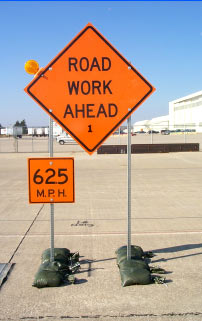 A safety orange warning sign for road construction sites. | |
| Hex triplet | #FF7900 |
| HSV (h, s, v) | (28°, 100%, 100%) |
| sRGBB (r, g, b) | (255, 121, 0) |
| Source | ANSI Z535 |
| ISCC–NBS descriptor | Vivid reddish orange |
| B: Normalized to [0–255] (byte) H: Normalized to [0–100] (hundred) | |
Safety Orange
#FF7900
#FF7900
Safety orange (also known as blaze orange, and a number of other names) was defined in ANSI standard Z535.1–1998 and is commonly used in a wide variety of contexts to warn of hazards, including: high-viz clothing, road cones, and as the background color in safety warning notices.
International orange (Aerospace)[]
| International Orange (Aerospace) | |
|---|---|
| Hex triplet | #FF4F00 |
| HSV (h, s, v) | (19°, 100%, 100%) |
| sRGBB (r, g, b) | (255, 79, 0) |
| Source | [Unsourced] |
| ISCC–NBS descriptor | Vivid reddish orange |
| B: Normalized to [0–255] (byte) H: Normalized to [0–100] (hundred) | |
International Orange
(Aerospace)
#FF4F00
#FF4F00
A shade of orange known as International orange is used in the aerospace industry to set objects apart from their surroundings, similar to Safety orange, but deeper and with a more reddish tone. It was the color used for the Space Shuttle pressure suits.
International orange (Golden Gate Bridge)[]
| International Orange (Golden Gate Bridge) | |
|---|---|
 The Golden Gate Bridge partially covered in fog | |
| Hex triplet | #F04A00 |
| HSV (h, s, v) | (18.5°, 100%, 94.1[1]%) |
| sRGBB (r, g, b) | (240, 74, 0) |
| Source | GGB |
| ISCC–NBS descriptor | Vivid reddish orange |
| B: Normalized to [0–255] (byte) H: Normalized to [0–100] (hundred) | |
The tone of international orange used to paint the Golden Gate Bridge in San Francisco, California is slightly lighter than the standard International orange used by military contractors and in engineering (shown below), thus increasing its visibility to ships. The 25 de Abril Bridge in Lisbon, Portugal also uses this color.[2]
Additional definitions of orange[]
Orange (Pantone)[]
| Orange (Pantone) | |
|---|---|
| Hex triplet | #FF5800 |
| HSV (h, s, v) | (21°, 100%, 100[3]%) |
| sRGBB (r, g, b) | (255, 88, 0) |
| Source | Pantone TPX[4] |
| ISCC–NBS descriptor | Vivid reddish orange |
| B: Normalized to [0–255] (byte) H: Normalized to [0–100] (hundred) | |
At right is displayed the color that is called orange in Pantone.
The source of this color is the "Pantone Textile Paper eXtended (TPX)" color list, color #021 TPX—Orange.[5]
Orange (Crayola)[]
| Orange (Crayola) | |
|---|---|
| Hex triplet | #FF7538 |
| HSV (h, s, v) | (18°, 78%, 100[6]%) |
| sRGBB (r, g, b) | (255, 117, 56) |
| Source | Crayola |
| ISCC–NBS descriptor | Vivid reddish orange |
| B: Normalized to [0–255] (byte) H: Normalized to [0–100] (hundred) | |
At right is displayed the color that is called orange by Crayola.
Orange was one of the original colors formulated by Crayola in 1903.
Other variations of orange[]
Papaya whip[]
| Papaya Whip | |
|---|---|
| Hex triplet | #FFEFD5 |
| HSV (h, s, v) | (37°, 16%, 100%) |
| sRGBB (r, g, b) | (255, 239, 213) |
| Source | X11 |
| ISCC–NBS descriptor | Pale yellow |
| B: Normalized to [0–255] (byte) H: Normalized to [0–100] (hundred) | |
Displayed at right is the web color papaya whip, a pale tint of orange.

Papaya whip is a representation of the color that would result if mashed papayas were blended with vanilla ice cream, whipped cream, or yogurt.[citation needed]
Peach[]
| Peach | |
|---|---|
| Hex triplet | #FFE5B4 |
| HSV (h, s, v) | (39°, 29%, 100%) |
| sRGBB (r, g, b) | (255, 229, 180) |
| Source | [Unsourced] |
| ISCC–NBS descriptor | Pale yellow |
| B: Normalized to [0–255] (byte) H: Normalized to [0–100] (hundred) | |
At right is displayed the color peach.

The first recorded use of peach as a color name in English was in 1588.[7]
Light orange[]
| Light orange | |
|---|---|
| Hex triplet | #FED8B1 |
| HSV (h, s, v) | (30°, 30%, 100%) |
| sRGBB (r, g, b) | (254, 216, 177) |
| Source | |
| ISCC–NBS descriptor | Pale orange yellow |
| B: Normalized to [0–255] (byte) | |
Displayed at right is the color light orange.
This color was formulated for Crayola colored pencils.
Apricot[]
| Apricot | |
|---|---|
| Hex triplet | #FBCEB1 |
| HSV (h, s, v) | (24°, 29%, 98[8]%) |
| sRGBB (r, g, b) | (251, 206, 177) |
| Source | Maerz and Paul[9] |
| ISCC–NBS descriptor | Pale orange yellow |
| B: Normalized to [0–255] (byte) H: Normalized to [0–100] (hundred) | |
At right is displayed the color apricot.
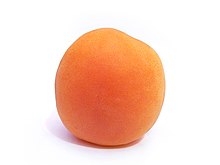
Apricot has been in use as a color name since 1851.[10]
Atomic tangerine[]
| Atomic tangerine | |
|---|---|
| Hex triplet | #FF9966 |
| HSV (h, s, v) | (20°, 60%, 100%) |
| sRGBB (r, g, b) | (255, 153, 102) |
| Source | Crayola |
| ISCC–NBS descriptor | Strong yellowish pink |
| B: Normalized to [0–255] (byte) H: Normalized to [0–100] (hundred) | |
Displayed at right is the color atomic tangerine.
This color was formulated by Crayola in 1990.
Atomic tangerine is supposed to be a fluorescent color, but there is no mechanism for showing fluorescence on a flat computer screen.
Xanthous[]
| Xanthous | |
|---|---|
| Hex triplet | #F1B42F |
| HSV (h, s, v) | (41°, 80%, 95%) |
| sRGBB (r, g, b) | (241, 180, 47) |
| Source | [1] |
| ISCC–NBS descriptor | Vivid orange yellow |
| B: Normalized to [0–255] (byte) H: Normalized to [0–100] (hundred) | |
The color xanthous is shown at right.
The color "xanthous" is derived from "xantho" (meaning yellow or golden), from the Ancient Greek ξανθός and "ous" (meaning full of), from the Latin adjectival suffix -ōsus.
Carrot orange[]

| Carrot orange | |
|---|---|
| Hex triplet | #ED9121 |
| HSV (h, s, v) | (33°, 86%, 93%) |
| sRGBB (r, g, b) | (237, 145, 33) |
| Source | Maerz and Paul |
| ISCC–NBS descriptor | Strong orange |
| B: Normalized to [0–255] (byte) H: Normalized to [0–100] (hundred) | |
Carrot orange is a tint of orange that is a representation of the color of the raw carrot vegetable.
The first recorded use of carrot orange as a color name in English was in 1684.[11]
Orange peel[]

| Orange peel | |
|---|---|
| Hex triplet | #FF9F00 |
| HSV (h, s, v) | (37°, 100%, 100%) |
| sRGBB (r, g, b) | (255, 159, 0) |
| Source | Maerz and Paul |
| ISCC–NBS descriptor | Strong orange |
| B: Normalized to [0–255] (byte) H: Normalized to [0–100] (hundred) | |
Displayed at right is the color orange peel.
A discussion of the difference between the color orange (the color halfway between red and yellow, shown below as color wheel orange) and the color orange peel (the actual color of the outer skin of an orange), may be found in Maerz and Paul.[12] Orange peel is the color halfway between orange (color wheel) and amber on the color wheel.
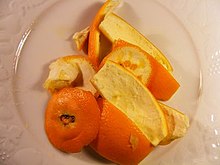
The first recorded use of orange peel as a color name in English was in 1839.[13]
Princeton orange[]
| Princeton orange | |
|---|---|
| Hex triplet | #EE7F2D |
| HSV (h, s, v) | (26°, 85%, 96%) |
| sRGBB (r, g, b) | (245, 128, 37) |
| Source | Princeton University |
| ISCC–NBS descriptor | Vivid orange |
| B: Normalized to [0–255] (byte) H: Normalized to [0–100] (hundred) | |
The first recorded use of Princeton orange as a color name in English was in 1928.[14]
The color symbolizes Princeton University and is defined as Pantone 158.[15] The equivalent RGB values vary among sources. One such color, closely matching that used on the defining pages at Princeton, is shown at right.
UT orange[]
| UT orange | |
|---|---|
| Hex triplet | #FF8200 |
| HSV (h, s, v) | (31°, 100%, 100%) |
| sRGBB (r, g, b) | (255, 130, 0) |
| Source | University of Tennessee[16] |
| ISCC–NBS descriptor | Vivid orange |
| B: Normalized to [0–255] (byte) H: Normalized to [0–100] (hundred) | |
This shade of orange is unique to the University of Tennessee (UT), defined by the institution as Pantone 151, and is called UT orange.[clarification needed] It is offered for sale by The Home Depot and licensed by the university. According to the university, this shade of orange is derived from the American daisy, which grew in profusion on the oldest part of the campus, The Hill. The University of Tennessee colors are UT orange and white, and are used across its various sports teams, advertising, and merchandise.
Spanish orange[]
| Orange (G&S) | |
|---|---|
| Hex triplet | #E86100 |
| HSV (h, s, v) | (25°, 100%, 91%) |
| sRGBB (r, g, b) | (232, 97, 0) |
| Source | Gallego and Sanz[17] |
| ISCC–NBS descriptor | Vivid reddish orange |
| B: Normalized to [0–255] (byte) H: Normalized to [0–100] (hundred) | |
Spanish orange is the color that is called anaranjado (the Spanish word for the colour "orange") in the Guía de coloraciones (Guide to colorations) by Rosa Gallego and Juan Carlos Sanz, a color dictionary published in 2005 that is widely popular in the Hispanophone realm.
Tangerine[]
| Tangerine | |
|---|---|
| Hex triplet | #F28500 |
| HSV (h, s, v) | (33°, 100%, 95%) |
| sRGBB (r, g, b) | (242, 133, 0) |
| Source | [18] |
| ISCC–NBS descriptor | Vivid orange |
| B: Normalized to [0–255] (byte) H: Normalized to [0–100] (hundred) | |

The first recorded use of tangerine as a color name in English was in 1899.[19]
Coral[]
| Coral | |
|---|---|
| Hex triplet | #FF7F50 |
| HSV (h, s, v) | (16°, 69%, 100%) |
| sRGBB (r, g, b) | (255, 127, 80) |
| Source | HTML/CSS[20] X11 color names[21] |
| ISCC–NBS descriptor | Vivid reddish orange |
| B: Normalized to [0–255] (byte) H: Normalized to [0–100] (hundred) | |
The web color coral is a shade of orange. It is displayed at the upper right.
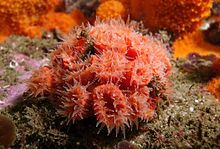
The first recorded use of coral as a color name in English was in 1513.[22]
Pumpkin[]
| Pumpkin | |
|---|---|
| Hex triplet | #FF7518 |
| HSV (h, s, v) | (24°, 91%, 100%) |
| sRGBB (r, g, b) | (255, 117, 24) |
| Source | Maerz and Paul[23] |
| ISCC–NBS descriptor | Vivid reddish orange |
| B: Normalized to [0–255] (byte) H: Normalized to [0–100] (hundred) | |
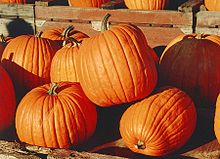
Pumpkin is a color that resembles pumpkins.
The first recorded use of pumpkin as a color name in English was in 1922.[24]
Pumpkin or orange is used with black for Halloween decorations.
Tangelo[]
| Tangelo | |
|---|---|
| Hex triplet | #F94D00 |
| HSV (h, s, v) | (23°, 100%, 90%) |
| sRGBB (r, g, b) | (249, 77, 0) |
| Source | [Unsourced] |
| B: Normalized to [0–255] (byte) H: Normalized to [0–100] (hundred) | |
Tangelo is a shade of orange that is the color of the outer skin of the tangelo fruit.
Saffron[]
| Saffron | |
|---|---|
| Hex triplet | #F4C430 |
| HSV (h, s, v) | (45°, 80%, 96%) |
| sRGBB (r, g, b) | (244, 196, 48) |
| Source | Maerz and Paul[25] |
| ISCC–NBS descriptor | Vivid yellow |
| B: Normalized to [0–255] (byte) H: Normalized to [0–100] (hundred) | |
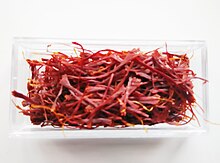
The first recorded use of saffron as a color name in English was in 1200.[26] It is considered as the most important colour in Hinduism. It is worn by the monks of the Theravada tradition.
Goldenrod[]

| Goldenrod | |
|---|---|
| Hex triplet | #DAA520 |
| HSV (h, s, v) | (43°, 85%, 85%) |
| sRGBB (r, g, b) | (218, 165, 32) |
| Source | X11 |
| ISCC–NBS descriptor | Strong yellow |
| B: Normalized to [0–255] (byte) H: Normalized to [0–100] (hundred) | |
Displayed at right is the web color goldenrod.
The color goldenrod is a representation of the color of some of the deeper gold colored goldenrod flowers.
The first recorded use of goldenrod as a color name in English was in 1915.[27]
Hunyadi yellow[]
| Hunyadi yellow | |
|---|---|
| Hex triplet | #E8AC41 |
| HSV (h, s, v) | (38°, 72%, 91%) |
| sRGBB (r, g, b) | (231, 172, 65) |
| Source | ColorSwatches |
| ISCC–NBS descriptor | Strong orange yellow |
| B: Normalized to [0–255] (byte) H: Normalized to [0–100] (hundred) | |
Displayed at right is the web color Hunyadi yellow or Pear gold. It is represented on the Hunyadi coat of arms.
Giants orange[]
| Giants orange | |
|---|---|
| Hex triplet | #FE5A1D |
| HSV (h, s, v) | (16°, 89%, 100[28]%) |
| sRGBB (r, g, b) | (254, 90, 29) |
| Source | [Unsourced] |
| ISCC–NBS descriptor | Vivid reddish orange |
| B: Normalized to [0–255] (byte) H: Normalized to [0–100] (hundred) | |
The color Giants orange is displayed at right.
This is the color that symbolizes, along with black and cream, the San Francisco Giants baseball team.
Persimmon[]
| Persimmon | |
|---|---|
| Hex triplet | #EC5800 |
| HSV (h, s, v) | (22°, 100%, 93[29]%) |
| sRGBB (r, g, b) | (236, 88, 0) |
| Source | Maerz and Paul[30] |
| ISCC–NBS descriptor | Vivid reddish orange |
| B: Normalized to [0–255] (byte) H: Normalized to [0–100] (hundred) | |

Persimmon is a color that resembles persimmons.
The first recorded use of persimmon as a color name in English was in 1922.[31]
Butterscotch[]
| Butterscotch | |
|---|---|
| Hex triplet | #E09540 |
| HSV (h, s, v) | (32°, 71%, 88%) |
| sRGBB (r, g, b) | (224, 149, 64) |
| Source | Pantone |
| ISCC–NBS descriptor | Strong orange |
| B: Normalized to [0–255] (byte) | |

Butterscotch is a color that resembles butterscotch.
Persian orange[]
| Persian orange | |
|---|---|
| Hex triplet | #D99058 |
| HSV (h, s, v) | (26°, 59%, 85[32]%) |
| sRGBB (r, g, b) | (217, 144, 88) |
| Source | ISCC-NBS |
| ISCC–NBS descriptor | Moderate orange |
| B: Normalized to [0–255] (byte) H: Normalized to [0–100] (hundred) | |
Persian orange is a color used in pottery and Persian carpets in Iran.
The first recorded use of Persian orange as a color name in English was in 1892.[33]
Orange pudding (milk added to pureed oranges that is mixed in a blender with flour and slowly boiled on a stovetop) is colored Persian orange, assuming no food coloring is added. Allis-Chalmers tractors have been colored Persian orange since 1928 so that, even when caked with dirt, they could still be distinguished from landscape features.[34]
Alloy orange[]
| Alloy orange | |
|---|---|
| Hex triplet | #C46210 |
| HSV (h, s, v) | (27°, 92%, 77[35]%) |
| sRGBB (r, g, b) | (196, 98, 16) |
| Source | Crayola |
| ISCC–NBS descriptor | Deep orange |
| B: Normalized to [0–255] (byte) H: Normalized to [0–100] (hundred) | |
Displayed at right is the color alloy orange.
Alloy orange is one of the colors in the special set of metallic Crayola crayons called Metallic FX, the colors of which were formulated by Crayola in 2001.
Although this is supposed to be a metallic color, there is no mechanism for displaying metallic colors on a computer.
Burnt orange[]
The examples and perspective in this section may not represent a worldwide view of the subject. (September 2019) |
| Burnt orange | |
|---|---|
| Hex triplet | #BF5700 |
| HSV (h, s, v) | (27°, 100%, 75%) |
| sRGBB (r, g, b) | (191, 87, 0) |
| Source | University of Texas at Austin[36] |
| ISCC–NBS descriptor | Deep reddish orange |
| B: Normalized to [0–255] (byte) H: Normalized to [0–100] (hundred) | |
Burnt orange has been used as a color name for this medium dark shade of orange since 1915.[37]
This color is one variation that is used as a school color of The University of Texas at Austin, Auburn University, and Virginia Tech.
Burnt orange is not a standard color; for example, it is defined differently by Auburn University[38][39] and the University of Texas at Austin.[36][40] The National Hockey League's San Jose Sharks use burnt orange as a secondary color,[41] and it is one of three colors of the National Football League's Cleveland Browns.[42][43] The Chicago Bears also use it as an alternate color.
Burnt orange was used by the University of Montana prior to 1996[44] and Oklahoma State University for its football uniforms from 1973 through 1983.[45]
Burnt orange was popular in interior design in the 1970s.
Burnt orange is also used to colour cylinders filled with the refrigerant R407C.[citation needed]
Tiger’s eye[]
At right is the color tiger’s eye.
It is named for the tiger’s eye gemstone, so named because its banding resembles the eye of a tiger. This color was formulated by Crayola in 1994 as part of the Gem Tones set.
| Tiger’s Eye | |
|---|---|
| Hex triplet | #B56917 |
| HSV (h, s, v) | (31°, 87%, 71%) |
| sRGBB (r, g, b) | (181, 105, 23) |
| Source | Crayola |
| ISCC–NBS descriptor | Deep orange |
| B: Normalized to [0–255] (byte) H: Normalized to [0–100] (hundred) | |
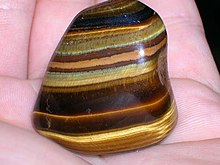
Brown[]
| Brown | |
|---|---|
| Hex triplet | #964B00 |
| HSV (h, s, v) | (30°, 100%, 59%) |
| sRGBB (r, g, b) | (150, 75, 0) |
| Source | [Unsourced] |
| ISCC–NBS descriptor | Strong brown |
| B: Normalized to [0–255] (byte) H: Normalized to [0–100] (hundred) | |
Brown, although an independent color term, actually combines the orange hue (or close to orange) with low brightness. It can be described as an especially dark orange or, in painters' terminology, a deep shade of orange.
The first recorded use of brown as a color name in English was in about 1000 AD in the Metres of Boethius.[46][47]
See also[]
References[]
- ^ "web.forret.com Color Conversion Tool set to hex code of color #F04A00 (International Orange (Golden Gate Bridge))".
- ^ "Frequently Asked Questions about the Golden Gate Bridge". Golden Gate Bridge. Archived from the original on 2015-08-10. Retrieved 2020-06-12.
- ^ Forret, Peter. "RGB Color converter – toolstudio". Web.forret.com. Retrieved 20 November 2017.
- ^ Type the word "Orange" into the indicated window on the Pantone Color Finder and the color will appear.
- ^ "- Find a Pantone Color – Quick Online Color Tool". Pantone.com. Retrieved 20 November 2017.
- ^ Forret, Peter. "RGB Color converter – toolstudio". Web.forret.com. Retrieved 20 November 2017.
- ^ Maerz and Paul A Dictionary of Color New York:1930--McGraw Hill Page 201; Color Sample of Peach: Page 41 Plate 9 Color Sample A5
- ^ Forret, Peter. "RGB Color converter – toolstudio". Web.forret.com. Retrieved 20 November 2017.
- ^ The color displayed in the color box above matches the color called apricot in the 1930 book by Maerz and Paul A Dictionary of Color New York:1930 McGraw-Hill; the color apricot is displayed on page 43, Plate 10, Color Sample 7F.
- ^ Maerz and Paul A Dictionary of Color New York: 1930—McGraw-Hill. See page 189 for year of first recorded use of color name reference and page 43, Plate 10 Color Sample 7F for color sample of Apricot.
- ^ Maerz and Paul A Dictionary of Color New York:1930 McGraw-Hill Page 192; Color Sample: Carrot Orange Page 43 Plate 10 Color Sample C11
- ^ Maerz and Paul A Dictionary of Color New York:1930--McGraw-Hill--Discussion of color Orange, Page 170
- ^ Maerz and Paul A Dictionary of Color New York:1930 McGraw-Hill Page 200; Colour Sample: Orange Peel Page 43 Plate 10 Color Sample L10.
- ^ Maerz and Paul A Dictionary of Color New York:1930 McGraw-Hill Page 202; Color Sample of Princeton Orange: Page 41 Plate 9 Color Sample K11
- ^ "Color – Office of Communications". Princeton University. Retrieved October 28, 2013.
- ^ "Our Palette". University of Tennessee, Knoxville–Office of Communications & Marketing. October 24, 2015. Retrieved October 24, 2015.
- ^ Gallego, Rosa; Sanz, Juan Carlos (2005). Guía de coloraciones (Gallego, Rosa; Sanz, Juan Carlos (2005). Guide to Colorations) Madrid: H. Blume. ISBN 84-89840-31-8
- ^ Nikolaev, 8Bytes studio, Koshevoy Dmitry. Ukraine. "HEX color #F28500, Color name: Tangerine, RGB(242,133,0), Windows: 34290. – HTML CSS Color". Htmlcsscolor.com. Retrieved 20 November 2017.
- ^ Maerz and Paul A Dictionary of Color New York:1930 McGraw-Hill Page 205; Color Sample: Tangerine Page 27 Plate 2 Color Sample H11
- ^ W3C TR CSS3 Color Module, HTML4 color keywords. W3C. (May 2003). Retrieved on 21 September 2008.
- ^ X11 rgb.txt Archived May 2, 2008, at the Wayback Machine. XFree86. (February 1994). Retrieved on 21 September 2008.
- ^ Maerz, Aloys John; Paul, Morris Rea (1930). A Dictionary of Color. New York: McGraw-Hill Book Company. p. 193.; color sample of coral: Page 27, Plate 2, Color Sample J10.
- ^ The color displayed in the color box above matches the color called pumpkin in the 1930 book by Maerz and Paul A Dictionary of Color New York:1930 McGraw-Hill; the color pumpkin is displayed on page 43, Plate 10, Color Sample H11.
- ^ Maerz and Paul A Dictionary of Color New York:1930 McGraw-Hill Page 202; Color Sample of Pumpkin: Page 43 Plate 10 Color Sample H11
- ^ The color displayed in the color box above matches the color called saffron in the 1930 book by Maerz and Paul A Dictionary of Color New York:1930 McGraw-Hill; the color saffron is displayed on page 43 Plate 10, Color Sample K8.
- ^ Maerz and Paul A Dictionary of Color. New York:1930 McGraw-Hill Page 203; Color Sample of Saffron: Page 43 Plate 10 Color Sample K8
- ^ Maerz and Paul A Dictionary of Color New York:1930 McGraw-Hill Page 196; Color Sample of Goldenrod: Page 43 Plate 10 Color Sample L5
- ^ Forret, Peter. "RGB Color converter – toolstudio". Web.forret.com. Retrieved 20 November 2017.
- ^ Forret, Peter. "RGB Color converter – toolstudio". Web.forret.com. Retrieved 20 November 2017.
- ^ The color displayed in the color box above matches the color called persimmon in the 1930 book by Maerz and Paul A Dictionary of Color New York:1930 McGraw-Hill; the color persimmon is displayed on page 35, Plate 6, Color Sample E12.
- ^ Maerz and Paul A Dictionary of Color New York:1930 McGraw-Hill Page 201; Color Sample of Persimmon: Page 35 Plate 6 Color Sample E12
- ^ Forret, Peter. "RGB Color converter – toolstudio". Web.forret.com. Retrieved 20 November 2017.
- ^ Maerz and Paul A Dictionary of Color New York:1930 McGraw-Hill Page 201; color sample of Persian orange: Page 43 Plate 10 Color Sample F10
- ^ Now called "Persian Orange No. 1" (Guy Fay, Andy Kraushaar, Original Allis-Chalmers, 1933–1957 2000:121; My Allis-Chalmers story
- ^ Forret, Peter. "RGB Color converter – toolstudio". Web.forret.com. Retrieved 20 November 2017.
- ^ Jump up to: a b "Color". University of Texas at Austin. Retrieved April 14, 2015.
- ^ Maerz and Paul A Dictionary of Color New York: 1930—McGraw-Hill (see under Burnt Orange in Index, Page 191)
- ^ "Official Colors". Auburn University. August 10, 2010. Retrieved April 14, 2015.
- ^ The shade of burnt orange used by Auburn University is RGB 221, 85, 12; HEX #DD550C.
- ^ The shade of burnt orange used by the University of Texas at Austin is Pantone 159; CMYK 0, 65, 100, 9; RGB 191, 87, 0; HEX #BF5700.
- ^ "Front Office Directory". San Jose Sharks. Retrieved April 14, 2015.
- ^ "Glidden Team Colors: 8-oz. #NFL-171A NFL Cleveland Browns Orange Interior Paint Sample". The Home Depot. Retrieved April 14, 2015.
- ^ The shade of orange used by the Cleveland Browns is RGB 240, 93, 53.
- ^ Moy, Chelsi (May 20, 2010). "UM President Dennison reflects on his legacy, MT". The Missoulian. Missoula, Montana. The Associated Press News Service.
- ^ Killackey, Jim (November 3, 1984). "It's Official! OSU's True School Color Will Be "PMS 166' Other Orange – Hues Taboo". The Daily Oklahoman. Stillwater, Oklahoma.
- ^ "brown, adj". Oxford English Dictionary. OUP. Retrieved 20 April 2011.
- ^ Maerz and Paul, Page 191
- Shades of orange
- Shades of brown
- Shades of yellow
- Shades of red





